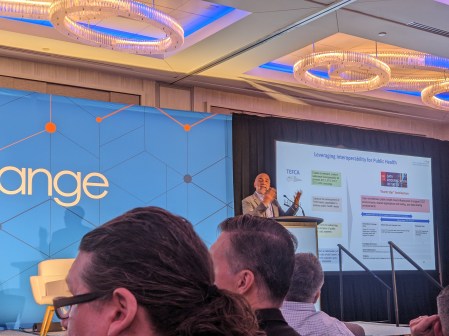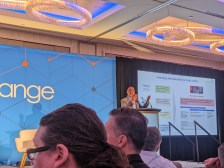Transition to federal health data standards an ‘unfunded mandate’ for smaller providers

Smaller health care providers aren’t adopting federal data standards as fast as the government would like due to an understandable technical skills gap, according to the chief of the IT Resource Branch of the National Center for Advancing Translational Sciences.
Speaking at AFCEA Bethesda‘s Health IT Event on Tuesday, Sam Michael said the transition to Fast Healthcare Interoperability Resource (FHIR) Release 4 (R4) is “going well” but is essentially an “unfunded mandate.”
To allow for easy sharing of standardized medical data for reporting and research purposes, the 21st Century Cures Act gives health-care providers, information exchanges and IT developers until December 31, 2022, to ensure their applications comply with FHIR R4. That’s easier for large, technically advanced hospital systems than small, non-technical health-care providers.
“This is no judgment at all,” Michael said. “I think everyone realizes there are different degrees of technical skill at different sites that are even submitting the data.”
NCATS, one of the National Institutes of Health, keeps data ingestion basic for non-technical organizations by using a secure file transfer protocol, but that takes some five minutes to complete and others the entire day, he added.
The agency continues to tout the benefits of FHIR R4 as a research tool, because it holds more data, with the hope of convincing more partners submitting data to quickly adopt the standard.
Other Department of Health and Human Services agencies like the Centers for Medicare & Medicaid Services, as well as the Department of Veterans Affairs, are all-in on FHIR standards and have teams working toward implementation. But in the case of the VA, the department is currently more focused on improving data quality between its two electronic health records: VistA and Cerner Millennium, said Chief Data Officer Kshemendra Paul.
“Yes, we have to push on standards really hard but that’s a long-lead-time activity, and we need to create the space to do that by dealing with the dirty, messy work of data management across legacy systems,” Paul said. “That’s kind of what eats my lunch and where I’m focused more than the standards, not because it’s not important, but because I’ve got to create space, and I think that’s probably a pattern that exists in other places.”
The COVID-19 pandemic revealed the “terrible” quality of medical data in many cases due to a lack of standards or following those that did exist, Michael said.
NCATS, like much of HHS, undertook a successful effort to harmonize data to standards by adopting the Observational Medical Outcomes Partnership (OMOP) Common Data Model many hospitals were providing COVID-19 data in, but increasing cloud connectivity has enabled the transition to FHIR.
“The data movement problem has gotten easier in some regards,” Michael said. “I want to say there are still a lot of challenges with that, but I think the ability for us to really adopt standards at an enterprise level, a national level, a global level really has gotten much greater.”





